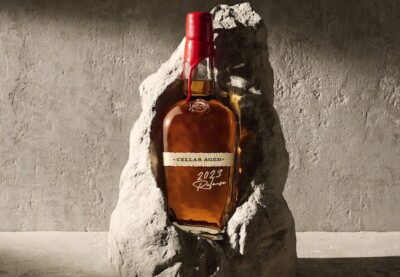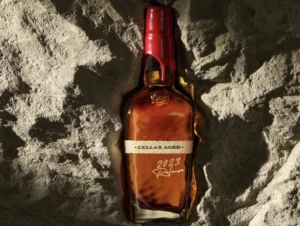When it comes to the world of bourbon, two names stand out prominently: Maker’s Mark and Woodford Reserve. These esteemed distilleries have crafted their own unique legacies in the realm of American whiskey, each with a rich history and distinct approach to the art of bourbon making.
In this head-to-head comparison, we delve into the world of Maker’s Mark vs Woodford Reserve, exploring their origins, production methods, flavor profiles, and the factors that make them favorites among whiskey connoisseurs.
Maker’s Mark Vs Woodford Reserve
Maker’s Mark and Woodford Reserve are both well-known Kentucky bourbon brands, and while they share some similarities, they also have distinct characteristics that set them apart. Here’s a comparison of the two:
Mash Bill:
- Maker’s Mark: Maker’s Mark uses a mash bill that primarily consists of corn (around 70%), with the remainder being red winter wheat (about 16%) and malted barley (around 14%). This mash bill creates a sweeter and milder flavor profile.
- Woodford Reserve: Woodford Reserve employs a mash bill that includes a higher percentage of rye (around 18%), along with corn (about 72%) and malted barley (around 10%). The higher rye content contributes to a spicier and more robust flavor.
Aging Process:
- Maker’s Mark: Maker’s Mark is aged for approximately six years in new charred oak barrels. This aging period allows the bourbon to develop a relatively mellow and balanced flavor profile.
- Woodford Reserve: Woodford Reserve is also aged for around six years, but it is known for its unique aging process in climate-controlled warehouses. The changing temperature fluctuations in these warehouses can lead to more complex and varied flavor profiles.
Flavor Profile:
- Maker’s Mark: Maker’s Mark is known for its smooth and approachable flavor with notes of caramel, vanilla, and a hint of fruitiness. It has a sweeter and softer taste compared to Woodford Reserve.
- Woodford Reserve: Woodford Reserve offers a more robust flavor with prominent notes of spices, including cinnamon and nutmeg, as well as dark fruits and toasted oak. It has a spicier and more complex taste.
Bottling Strength:
- Maker’s Mark: Maker’s Mark is typically bottled at 45% ABV (90 proof), making it slightly lower in alcohol content compared to some other bourbons.
- Woodford Reserve: Woodford Reserve is bottled at a slightly higher strength of 45.2% ABV (90.4 proof).
Price:
- The pricing of both Maker’s Mark and Woodford Reserve can vary depending on your location and the specific bottlings. However, they are generally in a similar price range, with Woodford Reserve sometimes being slightly more expensive.
Branding and Packaging:
- Maker’s Mark is known for its distinctive red wax seal on the bottle, which has become an iconic symbol of the brand.
- Woodford Reserve is often associated with its elegant and classic packaging, including a flask-shaped bottle.
Ultimately, the choice between Maker’s Mark and Woodford Reserve comes down to personal preference. If you prefer a sweeter and smoother bourbon, Maker’s Mark may be your choice. On the other hand, if you enjoy a spicier and more complex flavor profile, Woodford Reserve might be more to your liking. Both are highly regarded bourbons in their own right, and tasting them side by side can be an enjoyable way to explore the differences between them.
What is the aging period for Maker’s Mark bourbon?
Maker’s Mark bourbon typically ages for around 5 to 6 years. However, the exact aging period can vary slightly depending on factors such as batch size and production conditions. Maker’s Mark is known for its consistent flavor profile, which is achieved through a combination of factors, including the aging process in new charred oak barrels, the use of a specific grain bill, and the signature rotating barrel aging method.
This aging period contributes to the bourbon’s smooth and mellow flavor profile. Please note that specific batches or limited edition releases may have different aging periods, so it’s always a good idea to check the label for the exact information on a particular bottle.
What are the primary flavor notes in Maker’s Mark?
Maker’s Mark bourbon is known for its distinct flavor profile, which includes several primary flavor notes. These flavor notes are a result of the bourbon’s production process, including the specific grain bill, aging in new charred oak barrels, and the signature rotating barrel aging method. The primary flavor notes in Maker’s Mark bourbon typically include:
- Caramel: Maker’s Mark is known for its rich caramel flavor, which comes from the caramelized sugars in the charred oak barrels during the aging process. This sweetness gives the bourbon a smooth and approachable taste.
- Vanilla: Vanilla is another prominent flavor note in Maker’s Mark. It is often derived from the interaction between the bourbon and the charred oak barrels, as well as from the natural flavors of the grains used in the mash bill.
- Oak: The aging process in new charred oak barrels imparts a noticeable oakiness to Maker’s Mark. This oak character can bring complexity and depth to the bourbon’s flavor profile.
- Wheat: Maker’s Mark is a wheated bourbon, meaning that wheat is a significant component of its mash bill. This contributes to a softer, less spicy flavor compared to bourbons with a higher rye content. Wheat can introduce subtle, grainy sweetness to the flavor profile.
- Spice: While Maker’s Mark is not as spicy as some other bourbons due to its lower rye content, it can still exhibit hints of spice, such as cinnamon and nutmeg, which complement the overall flavor profile.
- Fruit: Some expressions of Maker’s Mark may have subtle fruity notes, such as cherry or dried fruit, which can add complexity to the bourbon’s flavor.
- Citrus: In some cases, you might detect citrusy undertones like orange or lemon zest, contributing to a bright and lively character.
It’s important to note that individual palates can vary, so while these are the primary flavor notes commonly associated with Maker’s Mark, your personal tasting experience may include additional nuances or variations. Tasting bourbon is a subjective experience, and the flavors can be influenced by factors such as the aging conditions, the environment in which you’re tasting, and your own sensory perceptions.
What is the significance of the red wax seal on a Maker’s Mark bottle?
The red wax seal on a Maker’s Mark bottle is not just a decorative element; it holds significant meaning and is an iconic part of the brand’s identity. Here’s why the red wax seal is significant:
- Hand-Dipped Tradition: Maker’s Mark is known for its commitment to handcrafted production methods. The red wax seal is applied by hand to each bottle, one at a time. This meticulous and labor-intensive process sets Maker’s Mark apart from many other distilleries that use automated sealing methods. It reflects the brand’s dedication to craftsmanship.
- Individuality: Each bottle’s wax seal is unique, bearing the marks of the individual who hand-dipped it. This adds a personal touch and emphasizes the brand’s commitment to quality and attention to detail.
- Authenticity: The wax seal serves as a tamper-evident feature, ensuring that the bottle remains sealed until it’s opened by the consumer. This helps guarantee the authenticity of the product and that it hasn’t been tampered with.
- Recognition: The red wax seal is instantly recognizable and is a key element of the Maker’s Mark brand identity. It has become an iconic symbol associated with the bourbon, making Maker’s Mark easily distinguishable on store shelves.
- Heritage: The red wax seal is a nod to the brand’s history and heritage. It was originally conceived by Margie Samuels, one of the founders of Maker’s Mark, who wanted a distinctive and eye-catching way to present the bourbon. She also believed that the red wax was reminiscent of her family’s distinctive red-capped bottle of Maker’s Mark’s earliest days.
Overall, the red wax seal on a Maker’s Mark bottle is a symbol of quality, craftsmanship, and authenticity. It has played a significant role in building the brand’s reputation and is cherished by bourbon enthusiasts worldwide.
How does the rye content affect the taste of Woodford Reserve?
The rye content in a bourbon like Woodford Reserve can have a significant impact on its flavor profile. Woodford Reserve is known for its balance and complexity, and the rye content plays a role in shaping its taste. Here’s how the rye content affects the flavor of Woodford Reserve:
- Spice and Pepper Notes: Rye is a grain known for its spiciness. In the case of Woodford Reserve, which has a relatively high rye content compared to some other bourbons, the rye imparts spicy and peppery notes to the flavor profile. This spiciness can be reminiscent of black pepper or baking spices like cinnamon and nutmeg.
- Herbal and Floral Undertones: Rye can also contribute herbal and floral undertones to the bourbon’s flavor. You might detect hints of mint, grassiness, or even subtle floral notes in Woodford Reserve, which add complexity and a touch of freshness.
- Dryness and Balance: Rye tends to produce a drier mouthfeel compared to corn-based bourbons. Woodford Reserve’s rye content helps balance the sweetness from the corn and the caramelized sugars from the barrel aging, resulting in a bourbon that is often described as well-balanced between sweetness and spice.
- Complexity: The presence of rye in the mash bill can enhance the overall complexity of the bourbon. Woodford Reserve is known for its layers of flavor, and the rye content contributes to this complexity by introducing a range of spicy, herbal, and woody notes that complement the other elements of the flavor profile.
- Finish: The rye content can influence the finish of Woodford Reserve. You may notice a lingering spiciness and warmth in the finish, which is characteristic of bourbons with a higher rye content.
It’s important to note that while rye contributes to these flavor characteristics, the overall taste of Woodford Reserve is also influenced by factors such as the specific aging process, the charred oak barrels used, and the distillation techniques employed. The combination of these factors, including the rye content, results in the unique and well-regarded flavor profile of Woodford Reserve.
What are the key ingredients in a typical bourbon mash bill?
A typical bourbon mash bill consists of a combination of grains, each of which contributes to the flavor profile and characteristics of the bourbon. The key ingredients in a typical bourbon mash bill are:
- Corn: Bourbon must be made from a grain mixture that is at least 51% corn. Corn is the primary grain in bourbon production and provides a natural sweetness to the spirit. The high corn content gives bourbon its signature caramel and vanilla notes.
- Rye: Rye is one of the secondary grains used in bourbon production. It adds spiciness and complexity to the flavor profile. The rye content in a bourbon mash bill can vary, but it typically ranges from 10% to 15%. Higher rye content can result in a spicier bourbon.
- Barley: Malted barley is another secondary grain used in bourbon production. It is responsible for producing enzymes needed to convert the starches in the grains into fermentable sugars during the mashing process. Barley is typically present in smaller quantities, around 5% or less, in a bourbon mash bill.
The specific ratios of these grains in the mash bill can vary from one bourbon brand to another and even between different expressions of the same brand. This variation in grain proportions, along with other factors such as the yeast strain used and the aging process, contributes to the diversity of flavors found in different bourbons.
Frequently asked questions
1. Question: What is the primary difference between Maker’s Mark and Woodford Reserve?
Answer: Maker’s Mark is known for its wheated mash bill, offering a softer and sweeter profile, while Woodford Reserve has a higher rye content, resulting in a spicier and more complex flavor.
2. Question: Which bourbon, Maker’s Mark or Woodford Reserve, is considered more premium?
Answer: Both Maker’s Mark and Woodford Reserve are considered premium bourbons, but Woodford Reserve is often positioned as a slightly higher-end brand within the bourbon category.
3. Question: Are there any significant variations in the aging process between Maker’s Mark and Woodford Reserve?
Answer: Both bourbons are aged in new charred oak barrels, but the aging conditions and time can vary. Maker’s Mark typically ages for around 5 to 6 years, while Woodford Reserve has a range of expressions with varying aging periods, including a standard 6-7 years of aging.
4. Question: Can you describe the flavor profiles of Maker’s Mark and Woodford Reserve briefly?
Answer: Maker’s Mark is known for its smooth, caramel, and vanilla notes with a touch of spice, while Woodford Reserve offers a spicier and more robust flavor profile with notes of cinnamon, nutmeg, and a hint of mint.
Conclusion
In the comparison of Maker’s Mark vs Woodford Reserve, both are highly regarded bourbon brands with their own distinct characteristics. Maker’s Mark is known for its smooth and approachable flavor profile, featuring prominent notes of caramel and vanilla. On the other hand, Woodford Reserve offers a more complex and robust flavor profile with a balance of sweetness, spice, and oakiness.
Ultimately, the choice between Maker’s Mark and Woodford Reserve comes down to personal preference. If you prefer a milder, sweeter bourbon, Maker’s Mark may be your go-to. However, if you enjoy a bourbon with a richer and more intricate flavor profile, Woodford Reserve is a great choice. Both are excellent options for bourbon enthusiasts, and the best one for you will depend on your individual taste preferences.




